
Limits, citation fish are commonplace as cobia move into Cape Lookout area
Matt Lamb at Chasin’ Tails Outdoors in Atlantic Beach said the spring cobia bite has ramped up to absolutely wide open in the past few days, with fish cruising bait pods, searching just outside the breakers and feeding on the bottom of channels everywhere from Cape Lookout to Bogue Inlet.
“We’ve had some good cobia runs in past years, and this one will compare with any of them,” said Lamb. “I’ve been the busiest I’ve ever been with our scales. Folks come in from a morning of fishing, and everyone has two cobia, and most of them are citation-size fish. Even the ones that aren’t are so close, you can’t tell by looking. By the time I get through getting all the measurements and filling out the citation forms, another group arrives and it starts all over.
“I’m not complaining,” Lamb said. “I’m glad to be busy and to see everyone catching fish. This is a good thing.”
Lamb hasn’t seen any huge cobia, but he expects they will come later, with most fish this week from 40 to 45 pounds. With fish so close to the beach, fishermen are catching cobia in everything from john boats to large sportfishermen.
“Fishermen are basically catching cobia one of two ways,” Lamb said. “They are sight-fishing along the beach and out the ship channel, or they are anchoring over near Cape Lookout and fishing a spread of baits on the bottom.
“I think sight-fishing is more exciting,” Lamb said. “You work along the beach a ways offshore of the surf or out the ship channel looking for bait pods. When you find one, you ease up to it and look hard for a big, dark shape. That dark shape is usually a cobia and once you spot it, you chunk a live eel to it and get ready. They’re feeding pretty heavily, and if one sees the eel, it will eat it. If all goes well, in about 20 minutes, you can gaff it and welcome it aboard.
Lamb (252-240-3474) said bottom-fishing seems slower but can get hectic quickly. He suggested fishing four lines evenly spaced around the boat and baiting them with chunks of fresh menhaden. If you’re fishing circle hooks, leave the reel in gear, and when the rod bends over, get ready to reel. With J-hooks, leave the reel out of gear and let the fish run a little before throwing the reel in gear and setting the hook.
According to Lamb, the basic eel rig is several feet of 80-pound fluorocarbon with a swivel on one end and a 7/0 to 9/0 Gamakatsu live-bait hook on the other. He prefers to fish it weightless but said some fishermen add a small egg sinker or split shot to make it sink faster. The eel is hooked through the lips.
Lamb said if live eels aren’t available, a bucktail and plastic eel trailer will get a cobia’s attention, but the fisherman has to work the bait to make it appear lifelike.
“Several of the largest cobia so far have been caught on the bottom near Cape Lookout,” Lamb said. “Most fishermen use fish-finder rigs with pyramid sinkers to hold the baits in place. Many fishermen use the same 7/0 to 9/0 Gamakatsu live-bait hooks as on eel rigs, but some prefer offset J-hooks or circle hooks. The preferred bottom bait has been pieces of fresh caught menhaden.”



